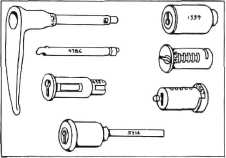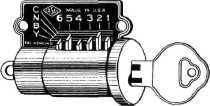1942 - 1947 CHEVROLET SHOP MANUAL
Section 1 Body
|
|
|||
|
1-29
|
|||
|
|
|||
|
Tapping on the lock with the wooden handle of
a hammer or screwdriver, while
pulling on the key, will
aid in removing the broken key. This loosens
the key as the tumblers are
jarred up and down from the
tapping. Occasionally a lock can be opened, when the key has
broken off, by leaving the broken
part of the key in the lock and forcing,
the remaining piece of the key
into the lock. Many times
this will allow the key to line up with the
tumblers and permit turning the
key, opening the lock.
Key Enters Lock but Lock Will Not Unlock
The side-bar type lock is used for the ignition
switch and door on passenger cars
and trucks, Fig. 55. In this type lock the key may sometimes enter
but the lock will not
unlock.
|
shaft, etc., where they will not show until the lock
is removed. The location of the
numbers on various type
locks is shown in Fig. 56.
|
||
 |
|||
 |
|||
|
Fig. 56-Identification Numbers on Locks
Many times it becomes necessary to cut new
keys by code or key numbers, and
the owner is not always in
possession of the number. By removing
either the door handle or door
pillar lock, the key
number for the door and ignition lock may be
obtained, as these two locks are
coded to the same key. The
glove compartment and rear compartment
lid locks are likewise coded to one key.
How to Code a Side-Bar Lock to a Key Number
Side-bar locks can be quickly coded to a certain key number to match
other keys on the car by the
following procedure.
Uncoded side-bar locks are furnished without
tumblers, springs or spring
retainers. These parts are
available separately. This type lock has six
tumblers cut to four different
depths. Service locks have
the tumbler depths indicated by colors, "B"
for black, "N" for nickel, "Y" for
yellow and "C" for copper.
Key codes, furnished with all key-cutting
machines, consist of numerals for the
tumbler positions and letters for
the tumbler depths.
How to Determine Code
of Key Using Key Decoder
|
|||
|
Fig. 55—-Layout of Side-Bar Lock Parts
If this should occur,
first see that the key is fully inserted, then tap the outside of the
lock with the wooden handle of a
hammer or screwdriver. If dirt
or chips are preventing the side
bar from falling into place, the tapping will force the bar to drop
into place and permit the
lock to turn. After opening
the lock, be sure to clean and lubricate at once to prevent a
recurrence of the condition.
Rusted Door Latches
Door safety locks
which will not operate when
assembled on the car will occasionally turn freely when removed. The
square shaft in this type lock
turns a dog which in turn locks
and unlocks the latch.
When this dog becomes rusty it results in
the latch being hard to turn.
Should this occur, use a
long spout oil can to force penetrating oil to the point where
the shaft enters the latch. This will
free the latch and allow the lock
to operate freely when in
place.
Rusty Door Handle Cylinder Cam
The small locking bolt operated by the cam on
the end of the lock cylinder, may
become rusted and while the
lock cylinder itself will operate, the
bolt may be frozen tight or be
hard to turn. In this case, remove the lock and free the bolt by
lubricating with oil or
graphite.
Identification Numbers on Locks
To protect car owners, automobile lock manufacturers
stamp the lock number on the lock core,
|
|||
 |
|||
|
Fig. 57-Key Decoder
|
|||
|
|
|||